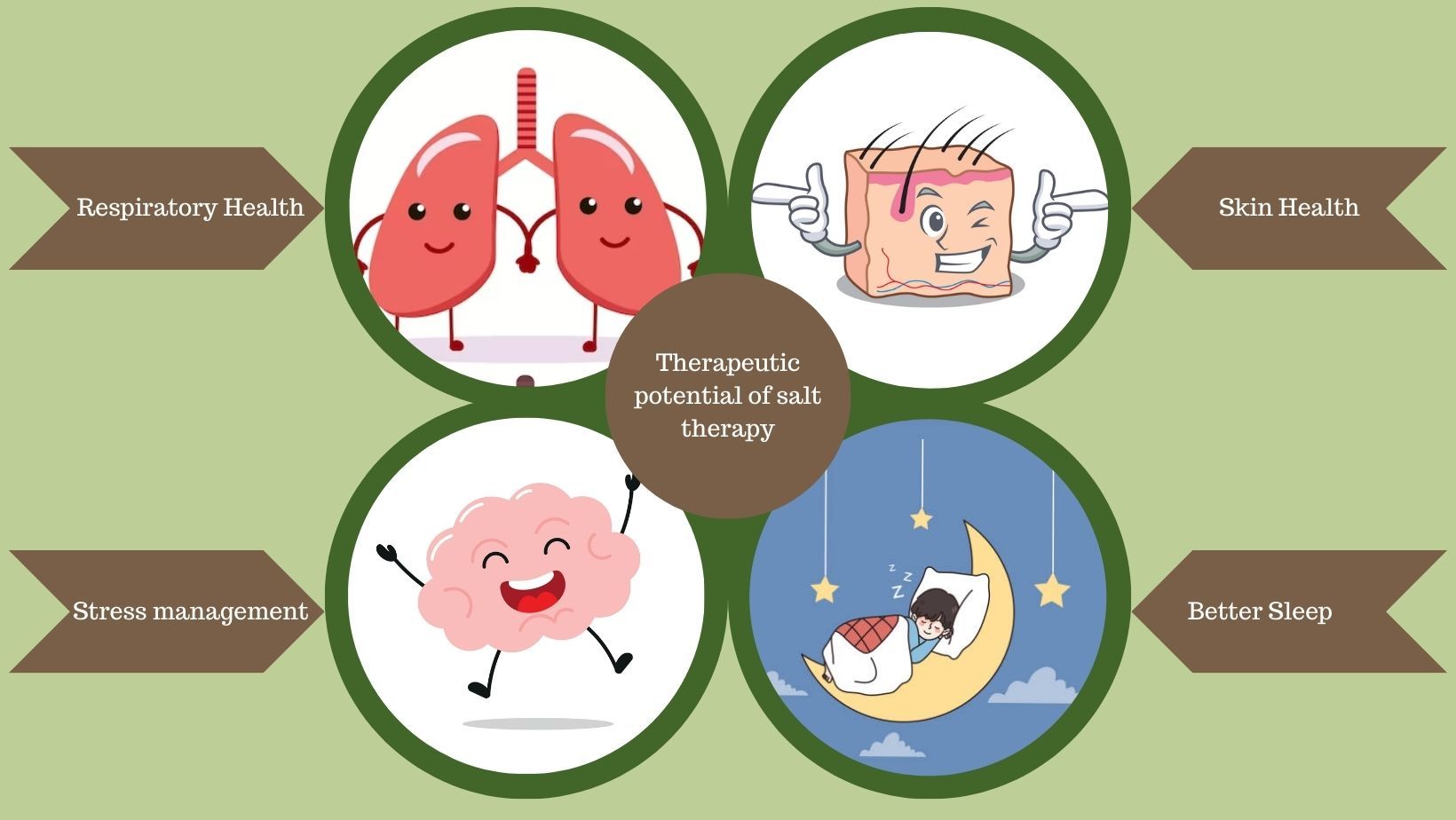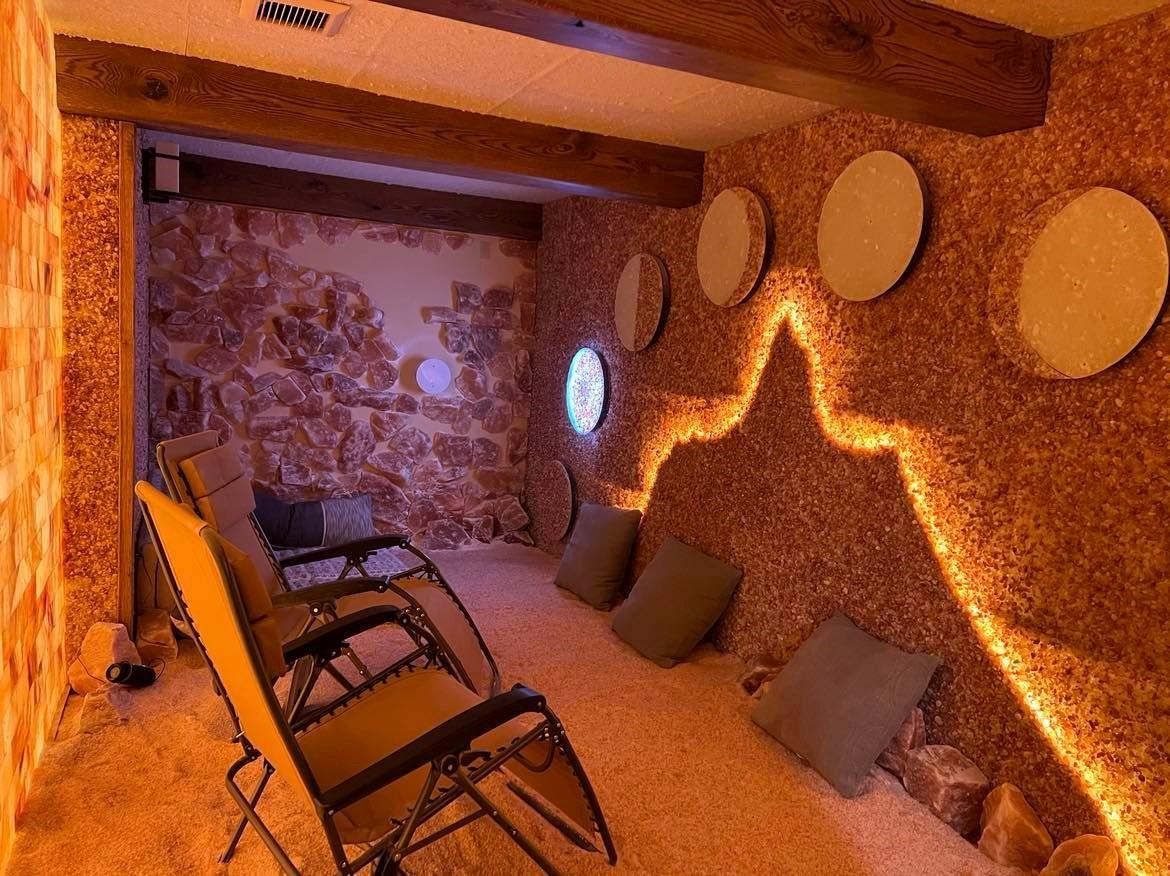Demystifying Salt Therapy: A revealing journey into the inner workings
In this article, we'll delve into the core principles of salt therapy, exploring its history, mechanism, and therapeutic potential. With each section, we'll lift the veil of mystery, shedding light on the science that makes salt therapy a transformative wellness pursuit.
The allure of salt therapy
Salt therapy, also known as halotherapy, has captured the attention of wellness seekers and curious minds alike. Wellness seekers are increasingly exploring the soothing ambiance of salt rooms, where walls glisten with salt crystals and the air is imbued with the essence of the sea. They're embarking on a journey that encompasses relaxation, respiratory relief, and skin rejuvenation, all while embracing the enduring allure of salt therapy in the contemporary wellness landscape. Its enigmatic charm lies in its promise of holistic healing through the inhalation of salt-infused air.
Findings from the survey conducted by the New York-based Global Wellness Institute in their Exploring Salt & Halotherapy Initiative reveal a set of compelling trends for the year 2023. It emphasizes the dominance of therapy layering, with the industry increasingly focusing on synergistically combining salt therapy with other treatments such as infrared saunas and red light therapies. Salt therapy is rapidly being incorporated into various wellness and fitness facilities, including float centers, cryotherapy, IV therapy, massage clinics, and gyms, creating one-stop wellness destinations. Another trend is the incorporation of beautiful Himalayan salt walls into existing saunas and rooms, both in commercial and residential settings, enhancing the aesthetic and therapeutic qualities of these spaces. These trends collectively signify the evolving landscape of salt therapy, reflecting a broader shift towards holistic well-being and innovation within the wellness industry.
What to expect in this journey
Before we venture deeper into the world of salt therapy, it's essential to set the stage. In this article, we'll delve into the core principles of salt therapy, exploring its history, mechanism, and therapeutic potential. With each section, we'll lift the veil of mystery, shedding light on the science, experiences, and benefits that make salt therapy a fascinating and transformative wellness pursuit.
Understanding Salt Therapy
Origins and History
Salt therapy, or halotherapy, has a rich history dating back to ancient civilizations. Modern salt therapy originated from the salt mines in Europe and Russia. It was believed that these salt mines had healing properties, and those who ventured into these underground sanctuaries experienced relief from various ailments. Fast forward to the modern era, and the principles of salt therapy have been harnessed in a more controlled environment known as salt rooms.
The Wisdom of Ayurveda
It's fascinating to note that Ayurveda, the ancient system of medicine that originated in India over 5,000 years ago, has long recognized the value of salt, particularly Himalayan salt, referred to as Saindhava lavana. This in-land sea salt has a unique geological history that sets it apart. Himalayan salt is not your typical table salt. It is an ancient mineral deposit that dates back several thousands of years and was formed when a pre-existing ocean dried up, leaving behind salt deposits in the Himalayan region. This unique geological origin means that Himalayan salt is less exposed to environmental pollutants and harmful substances like mercury, making it a purer and healthier choice.
Himalayan salt represents a bridge between the past and present, a mineral with timeless therapeutic potential.In Ayurveda, Saindhava lavana is highly regarded for its ability to balance all three doshas: vata, pitta, and kapha. Ayurvedic texts, such as Charaka Samhitha, advocated the daily use of Saindhava lavana in various forms, such as adding it to meals or dissolving it in water. Its versatility in treatment extends to various health conditions like respiratory disorders, joint disorders, gastro-intestinal disorders, etc making it a staple in Ayurvedic healing practices.
Asian Culture
In traditional Asian cultures of countries like India and Korea, salt has connotations of purity and protection. Salt is sometimes included in religious ceremonies and offerings as a symbol of purity. It's often used to create protective circles or barriers, believed to shield against negative forces or energies. Salt is also sprinkled in homes to purify the environment and keep it free from negativity.
The use of salt as a means of repelling negative energy is a reflection of the cultural significance and deep-rooted traditions in these regions. It's a testament to the diverse roles that salt plays, not just in daily life but also in spiritual and cultural practices.
How it works at its core
At the Heart of Salt Therapy: The Healing Power of Salt-Infused Air
Salt therapy, also known as halotherapy, is a holistic approach to wellness that centers around a captivating concept: the remarkable healing power of salt-infused air. Salt therapy is, at its essence, a natural approach to health that harnesses the curative properties of salt, specifically pharmaceutical-grade salt. It involves the dispersion of micro-sized salt particles into the air of a salt room, creating an environment rich in these therapeutic particles. Imagine a room where you can breathe in tiny salt particles, just like the air inside salt caves. This room is cozy, with a comfortable temperature and low humidity. But what happens when we inhale this salt-infused air?
The Respiratory System's Interaction with Salt
When we breathe in the salt-laden air during a salt therapy session, these minute salt particles (diameter <3 μm) begin their therapeutic journey. They travel deep into the respiratory system, reaching areas that are often challenging to access through conventional treatments. This is where the magic of salt therapy unfolds.
Alleviating Inflammation
One of the primary benefits of salt therapy lies in its ability to alleviate inflammation. Inflammation is a natural response of the body to injuries or irritants, but when it becomes chronic, it can lead to a host of health issues, including respiratory conditions. When you breathe in salt and it gets to your lungs, the high osmotic pressure of salt helps reduce the swelling in the inner layer of your airways, which we call the bronchial mucosa. Thereby, microscopic salt particles have an anti-inflammatory effect on the airways, helping to reduce the swelling and irritation associated with conditions like asthma and bronchitis.
Clearing Mucus and Improving Breathing
The salt particles, as they make their way into the deeper regions of the respiratory system, have another crucial role to play. They interact with excess mucus, which can obstruct air passages and hinder proper breathing. The salt's presence thins and loosens the mucus, making it easier for the body to expel and cough out bad stuff like air pollution and allergens. This process is particularly beneficial for individuals with respiratory conditions, as it can enhance their lung function and overall well-being.
Fortifying the Immune System
Beyond alleviating symptoms, salt therapy takes a step further by fortifying the immune system. The salt particles stimulate the production of immune cells called phagocytes, bolstering the body's defenses against infections and diseases. Not only that, but they can also stop the growth of harmful bacteria and sometimes even kill them. This immune-boosting effect is particularly valuable for individuals looking to maintain their health or support their recovery.
Unwind, De-Stress, and Sleep Better
Salt therapy doesn't just stop at the respiratory system; it also works its magic on your central nervous system. The salt particles that you inhale contain a high concentration of negative ions. These ions are like mood-lifters for your body. They increase the levels of a brain chemical called serotonin in your blood, which is responsible for improving mood, alertness, anxiety, depression, and even your sleep. So, by enjoying salt therapy, you're not just helping your lungs; you're also giving your nervous system a chance to relax, manage stress, and enjoy better, more restful sleep.
Revive your skin
Let's dive into how salt works its magic on your skin. Himalayan salt is rich in minerals like magnesium, calcium, potassium, and sodium. When you experience salt therapy, your skin eagerly absorbs these minerals, and they act on the electrophysiological channels of your skin.
Magnesium is like the fountain of youth for your skin, reducing water retention and slowing down the aging process. Calcium gives your skin a boost in blood circulation and keeps it from holding onto excess water. Potassium helps balance your skin's hydration, making it a savior for those with skin that can't decide if it's too oily or too dry. Sodium plays a crucial role in maintaining fluid balance in your skin.
Salt therapy doesn't stop there; it does wonders for your skin. It boosts circulation and keeps your skin's pH levels in check, helping you fend off the signs of aging. It can enhance moisture levels, smooth out rough patches, and soothe redness. That makes it a game-changer for people dealing with skin conditions like acne, eczema, rosacea, psoriasis, or dermatitis. So, not only does salt therapy help you breathe easier, but it also gives your skin a radiant, healthy glow.

A Holistic Approach to Well-Being
Salt therapy's approach to healing is holistic, addressing both the symptoms and the underlying causes of various health conditions. By creating an environment rich in therapeutic salt particles, it provides individuals with a natural and complementary way to manage their well-being. This concept aligns with the growing interest in alternative and holistic approaches to health and wellness.
In conclusion, salt therapy is like a workout for your lungs, making them work better and reducing any inflammation. This captivating approach to well-being offers hope to those seeking relief from respiratory issues, skin conditions, and stress, embodying the transformative potential of natural therapies. The allure of salt therapy lies in its ability to enhance the quality of life, providing a path to better health and wellness through the simple, yet profound, gift of salt-infused air.
Safety Considerations: Is salt therapy safe for everyone?
When it comes to your well-being, safety should always be at the forefront of any wellness endeavor. The good news is that salt therapy is generally considered safe for most individuals. However, like any therapeutic practice, it's essential to consider specific cases where additional precautions may be necessary.
For children, salt therapy can be a safe and valuable option, particularly for those dealing with respiratory issues such as asthma, allergies, or recurrent infections. The gentle and non-invasive nature of salt therapy makes it an appealing choice for parents seeking alternative solutions to traditional medications. It's important, however, to ensure that the salt room or chamber is child-friendly and that sessions are adapted to their age and comfort level.
Certainly, some contraindications to salt therapy are vital to consider. Individuals with severe hypertension, cancer, acute respiratory disease, tuberculosis, and bleeding disorders should exercise caution and seek professional guidance before engaging in salt therapy. Their health and well-being should always be the top priority, and a consultation with both their healthcare provider and the salt therapy facility is crucial. This collaborative approach ensures that the salt therapy experience is customized to their specific needs and that any potential risks or dangers are effectively addressed and averted.
Potential side effects
The potential side effects of salt therapy are usually minor and transient. They may include a temporary increase in coughing or mucus production, skin dryness, or mild throat irritation. These effects are often a sign that the body is responding to the therapy and are typically well-tolerated. In some cases, individuals with certain skin conditions may experience temporary skin redness or tingling.
It's crucial to note that these side effects are part of the body's natural detoxification and adjustment process to the therapy. They are not a cause for concern and tend to subside with continued sessions.
Integrative medicine for optimal health
Choosing between salt therapy and conventional medicine need not be an either-or decision. In fact, the beauty lies in the integration of both approaches to create a comprehensive strategy for health and wellness. This harmonious blend can offer the best of both worlds, addressing the unique requirements of your body and circumstances.
For example, individuals with respiratory conditions can benefit from salt therapy as a complementary treatment. It can ease symptoms and enhance lung function, allowing patients to potentially reduce their reliance on medications like inhalers or steroids. Similarly, those dealing with skin disorders can find relief in the natural healing properties of salt therapy alongside prescribed dermatological treatments.
The optimal path to health and wellness doesn't have to be a matter of choosing one method over the other. By integrating salt therapy and conventional medicine, you can embrace a holistic approach that addresses the physical, mental, and emotional aspects of your well-being. It's a dynamic strategy that allows you to tailor your health journey to your specific needs, recognizing that sometimes the best solutions come from embracing the strengths of different approaches.
The Salt Room Experience
Step into a Salt Room
Imagine yourself walking through the door of a serene sanctuary, where the very walls seem to shimmer with the glint of salt crystals and the air carries a subtle but unmistakable essence of the sea. This is the moment you step into a salt therapy room, where the very design and ambiance set the stage for a unique experience that combines relaxation, rejuvenation, and the timeless allure of nature's wonders.
The walls are more than just walls; they're constructed of Himalayan salt bricks, hewn from ancient mineral deposits and carefully arranged to create an environment that's both visually stunning and health-promoting. The soft, ambient lighting enhances the warm, welcoming atmosphere, inviting you to leave the stresses of the outside world behind and embark on a journey to well-being.

What Happens During a Session
As you settle into a comfortable chair or recline in the salt room, you'll soon find that salt therapy takes on a dynamic role in your wellness routine. It's not merely about inhaling salt-laden air; it's a holistic experience that engages your senses and nurtures your body.
Your journey begins as you inhale the air, which is infused with pharmaceutical-grade salt particles, much like the salty sea breeze on a tranquil beach. These microscopic salt particles are dispersed into the air by a halogenerator, and as they enter your respiratory system, the magic begins.
The soft, granulated texture of the salt beneath your feet provides an earthy connection to nature, grounding you in the present moment. The tranquil environment, often accompanied by calming music or guided meditation, sets the stage for relaxation.
As you recline or sit in the salt room, you might observe the subtle shifts in your body's responses. Stress begins to melt away, you breathe easier, your muscles relax, and a sense of calm envelops you. It's not just about the physical benefits; it's a mental and emotional journey as well.
The salt room experience is more than a wellness treatment; it's an immersion in the soothing embrace of nature's gift. Each session offers an opportunity to reset, rejuvenate, and rediscover the harmony between your well-being and the world around you. So, whether you're seeking relief from respiratory issues, stress, or simply a serene escape, the salt room experience beckons you to step inside and embark on a journey of healing and relaxation.
